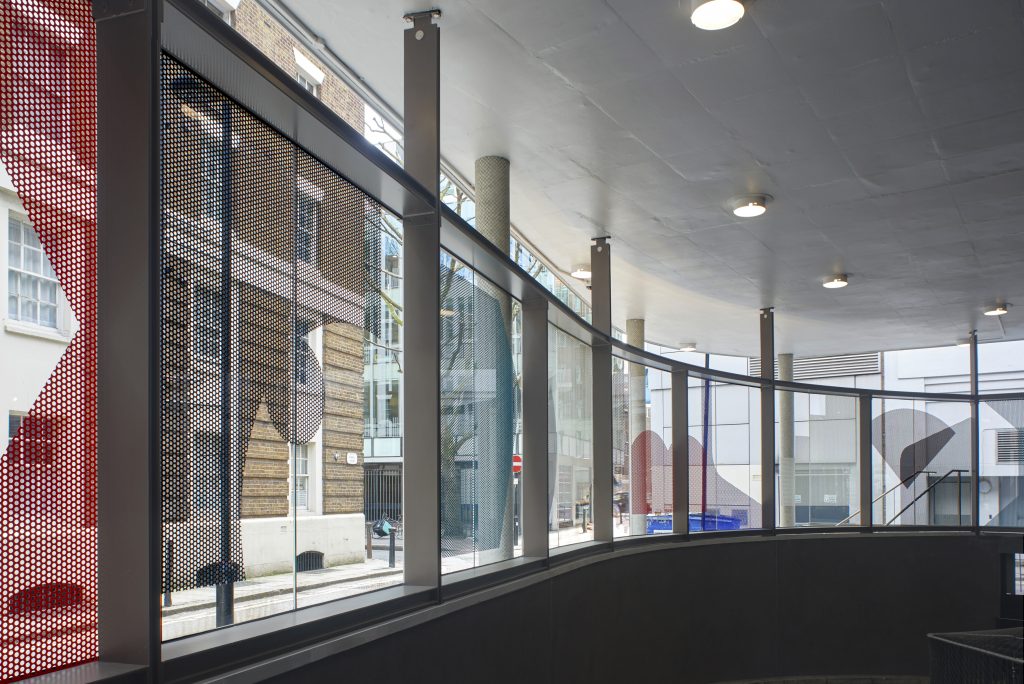Hugh Broughton Architects’ ongoing redevelopment of the Trades Union Congress (TUC) London headquarters, Congress House, reached a significant milestone this week as the TUC unveiled a permanent public artwork commission for the Grade II* listed building. Commissioned by culture and placemaking consultancy Futurecity, Berlin-based visual artist Eva Berendes has created a glass screen, clearly demarcating the entrance to the revitalised south side of the building at the junction of Dyott Street and Bainbridge Street. It is a striking artwork that will visually reflect the TUC’s values and history.
In Fitzrovia, just north of New Oxford Street and a few minutes’ walk from the British Museum, the location of the TUC’s Congress House headquarters on Great Russell Street couldn’t be more central. The creation of new rentable offices and revamped staff facilities at Congress House will bring new tenants to the south side of the building. Named The Rookery, this flagship refurbishment takes its name from the term coined in the eighteenth century to describe densely populated, gloomy alleyways which characterise the back streets off Great Russell Street.
The TUC has a reputation for embedding the arts into the fabric of its building. It began in 1957 with the opening of the original Modernist building designed by David du Rieu Aberdeen, which included a monumental set piece in the courtyard created by sculptor Sir Jacob Epstein as a memorial to fallen trade union members from both wars. This seminal work is now protected by a steel and ETFE roof canopy installed in 2016 as an earlier phase in Hugh Broughton Architects’ phased redevelopment.
Eva Berendes’ artwork will unfold across the curved car ramp, animating the building’s Dyott Street façade. The design comprises bold, colourful geometric forms inspired by motifs used in the enamel badges of the affiliated unions, an important part of the trade unions’ identities. The glass screen is mounted on a grey Yorkstone dwarf wall, matching the main entrance steps on Great Russell Street.
The artist considers the screen as a ‘promenadic’ painting, following the curve of the building to engage passersby and set up a dialogue between the institution and the life of the street, the footfall of which is expected to increase dramatically when Crossrail arrives at Tottenham Court Road Station in 2018.
The designs are hand sandblasted into the glass and filled with ceramic paint, in a process known as ‘ceramic bake’, to achieve a fine-textured relief, a technique which will continue the legacy of craftsmanship associated with the building.
The new illuminated entrance will open into a spacious ground floor reception space, which incorporates an informal meeting space. The design extends the original material palette and modernist idiom. Refurbished rentable offices will be created from ground to fifth floors, and revamped staff facilities will be created at basement level. Refurbishment of the south side for the use of tenants will reinstate the original plans of David du R Aberdeen, whose layouts included entrances on both north and south sides of the building.
The refurbishment and art installation will be unveiled in January 2018 as part of the TUC 150th anniversary celebrations.
Andy Robinson, Senior Strategist, Futurecity, said:
“Eva’s practice is dynamic, surprising, and contemplative. It is exciting to be able to commission her first permanent architectural artwork within such an engaging context as the heart of the TUC in London. Her widening of an approach to the Formalist artistic movement takes on the site’s specific social and cultural context. Building users and passersby will be able to recognise and enjoy its subtle referencing and interpretation of the TUC and its values.”


Photography by Andy Keate
